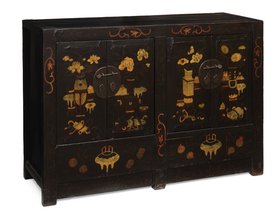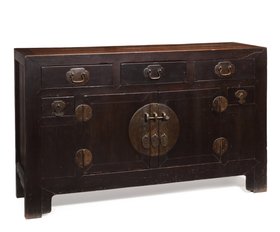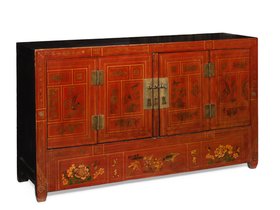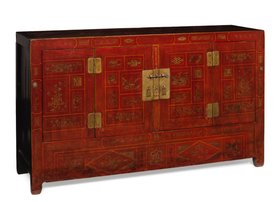
Original price
GBP £ 2995
Converted price
Description
 DeepL Translate
DeepL TranslateShanxi, circa 1830
This richly decorated sideboard originates from Shanxi province and dates to the early nineteenth century. Shanxi’s furniture-making traditions during the late Qing period were renowned for their strong forms and expressive painted decoration, and this piece is an excellent example of that style. With its dark lacquered surface, warm ochre and red pigments, and imagery drawn from scholarly and auspicious themes, the cabinet has an understated elegance and wonderful character.
The cabinet is constructed in elm and finished in black lacquer to provide a dramatic backdrop for the painted decoration. Across the front are once vibrant paintings executed in warm yellows, soft greens and russet tones - now in more muted colours but still standing out beautifully against the dark background.
The painted motifs show a variety of scholar’s objects arranged in still-life compositions. These include calligraphy brushes, scrolls and books to symbolise learning and cultivated life; vases and censers represent purity and refinement and various fruits and floral sprays convey prosperity and harmony. These various objects belong to the classical theme of the “Hundred Antiques” (bai gu), a decorative vocabulary widely used in the Qing dynasty to express respect for tradition and scholarship. Although time has gently worn the lacquer and pigments, the images remain clear and atmospheric, retaining the charm and depth of early 19th-century folk painting.
Outside of the main paintings, pomegranates and other fruit are repeated on the lower apron to denote fertility, abundance and a wish for numerous offspring. Five highly stylised dragons are shown framing the doors as a further decorative element and as protection against evil influences.
The original round brass lock plates are long since lost, replaced with new hardware in a similar style. Behind the twin sets of doors are two spacious interior compartments, each fitted with a single removable shelf, making the sideboard highly practical for modern storage. The back and interior surfaces are finished in the same black lacquer, preserving a unified appearance and reflecting traditional Shanxi workmanship.
By the early 19th century, Shanxi was home to powerful merchant clans whose wealth supported a flourishing decorative tradition. Furniture of this kind, painted in warm tones on dark lacquered surfaces, was common in wealthy homes throughout the province—particularly in reception areas where colour and symbolism played an important role in welcoming guests. The scholarly motifs seen here reflect the aspirations of the household, while the darker lacquer finish was both practical and fashionable in northern China, where strong contrasts and robust surfaces were preferred.
With its atmospheric colours, rich but subtle painted detail and strong proportions, this sideboard would make a striking addition to a modern interior, ideal for use in a dining room, living space or hallway. Beautifully preserved yet clearly bearing the patina of age, this is a fine and evocative example of early 19th-century Shanxi furniture—decorative, functional, and full of cultural meaning.
Last updated: 26/11/25
More images from Shimu
£2595
5887x4866 (10.44MB)
26/11/25


£1845
6009x4500 (14.64MB)
26/11/25


5924x4285 (2.64MB)
26/11/25


£2595
6539x4362 (2.84MB)
26/11/25


Recently viewed
£804
5655x8482 (4.73MB)
28/10/25


£545
5202x4480 (5.8MB)
30/10/25









